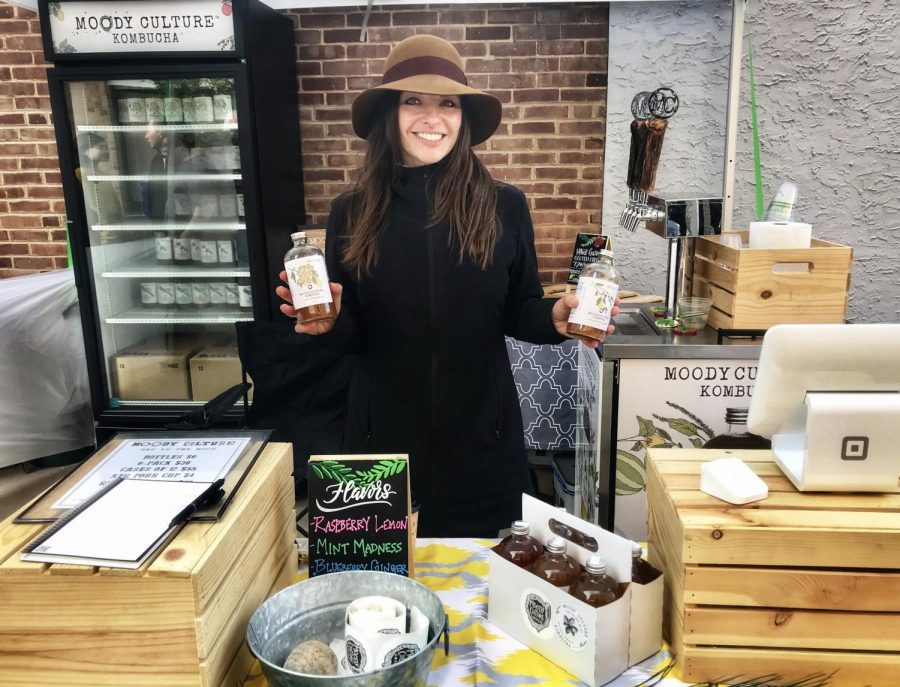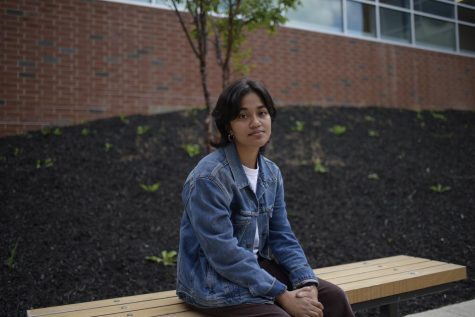More Than a Teacher: Lisa Harpster
Photo Courtesy of Lisa Harpster
Harpster standing at the Moody Culture booth at Pop Up Ave. Taken in State College, PA.
December 31, 2020
It can be hard to think of teachers as anything more than “teachers.” In a normal school year, we’re in and out of their classrooms for 90 minutes every other day, and for many, those 90 minutes are spent staring at the clock, waiting for the minutes to pass by. If they’re lucky, students get the chance to crack a few jokes with their teachers here and there. For the especially fortunate, they get to really talk with their teachers. Students might share a part of themselves, and in turn, get to know a bit about their teacher outside of the classroom. For those who partake in these conversations, one thing is made clear: teachers lead as rich a life outside the classroom as students do. This certainly rings true for Lisa Harpster, an English as a Second Language (ESL) teacher who, when she’s not in school, is an avid artist and local business owner.
Even in high school, Harpster was immersing herself in the worlds of art and ESL. If she wasn’t painting, you’d probably find her dancing, and when she had time, she would volunteer in the ESL classroom for extra credit for her World Cultures class. Her experiences in the classroom were eye-opening.
“I just loved being around people from all over the world, and I think I realized how narrow my view was, and how small of a town I was in when I started to meet more and more people from all over the world and all different cultures,” Harpster said.
Harpster carried her experiences from high school with her, and when she realized she wanted to go back to school after acting in New York for a period of time, she had an idea of the path she wanted to tread.
“I loved the ESL classroom and I knew I loved art, so I knew I wanted to be either an art teacher or an ESL teacher,” Harpster said.
Linda Barton, who had been Harpster’s World Cultures teacher in high school, introduced her to the Professional Development School (PDS) intern program at Penn State. It was Barton’s last year teaching, and after Harpster finished the program, she filled the position. She now teaches at State High, and through her years of teaching, there have been a few stand out moments that she’ll never forget.
“I got this long email from a student and it went to me and it went to my colleague, Andy Wilson, who teaches ESL social studies,” Harpster said. “He sent us a picture of the cool food he made. He made this Mexican turkey recipe, and he was so excited about it and proud of it and talked about just what he learns in class and perspectives that he’s gained from class. When things like that happen, I know that I’m in a pretty amazing job.”
In addition to these relationships she builds with students, Harpster feels incredibly lucky to see friendships form between students.
“Something else that’s actually really cool is when I see in my classroom friendships that form, whereas in their countries they never would. Like their counties might be at war, or they [practice] totally different religions that don’t agree at all, and yet they are great friends. And then ten years later I still see them having a reunion together, they’ll, you know, send me a picture on Facebook. Those I think are the big moments that are super cool. Yeah, I feel pretty lucky,” Harpster said.
Outside of teaching classes, the ESL department focuses on supporting families. Whether that’s family involvement–hosting potlucks and game nights–or linking them with community resources, the duties of the ESL department extend far beyond the classroom.
“The role of an ESL teacher is kind of–you’re definitely a language teacher but you kind of take on almost like a cultural liaison role, with the family often, because you’re the first ones that they know. We often end up helping them find an attorney, or maybe get healthcare, or find out how to get to the dentist,” Harpster said.
When the pandemic hit, the work outside the classroom continued. A number of the ESL families have been disproportionately impacted and further marginalized by the pandemic, and the ESL department recognized the need to support families heavily impacted by COVID-19. Upon recognizing this need, faculty members set out to raise money.
“We’ve raised, I mean I think we’re over $50,000 now. We’ve been able to help with rents and food and emergency bills and car repairs,” Harpster said.
The pandemic impacted the ESL department in more ways than one. Typical community-building events made to bring students, families, and teachers together have been put on hold.
“That’s one of the saddest things, actually, we can’t have our big potlucks in the classroom this year. We do that every year and everyone brings in food from their country,” commented Harpster on the lack of family involvement events this year due to the pandemic.
These events outside the classroom don’t only act as a way for families to get acquainted with one another–they’re valuable learning experiences as well. For Harpster personally, she learned to love a million different kinds of food that she wouldn’t have gotten the chance to try otherwise. But more than that, Harpster learns valuable life lessons from her students.
“I learn different perspectives, I learn different ways of being a human that I think most of us in the United States don’t see. […] I think I gain an appreciation for the world that I don’t think would be possible unless I were someone to really seek it out. I feel really fortunate that it happens to be in my daily life,” Harpster said.
Not many people get the chance to widen their world view simply through their career, but Harpster’s position as an ESL teacher allows her to do just that. On top of gaining a unique perspective through her career, the way in which Harpster views her role as a teacher is a bit different than one might expect.
“I think of my role as–I hope–a human they can look up to as being more important than a teacher. […] I more hope that they can just think that I’m a good human to be around as opposed to a teacher,” Harpster said.
When asked about the most gratifying part of her job, Harpster confidently responded, “my students.”
“They (students) come in and tell me a story, or there’s something going on with their family that they come in and share with me, or they tell me a funny thing that happened. It’s also really cool to get to see them, to watch them […] after they graduate,” Harpster said.
When talking about her students, Harpster recalled a specific student of hers. She entered the classroom never having before seen a computer, and has since majored in international business and is currently working in D.C.
“Yeah. I have pretty incredible students,” Harpster said.
In having worked so closely with the ESL students, there are certain misconceptions that Harpster wishes to dispel.
“I think when a lot of people come into contact with somebody who is from a different culture and speaks a different language, there’s this automatic fear and therefore they don’t communicate with them, they don’t talk to them, they ignore them, they don’t try to have a conversation in any way, shape, or form. That is one major misconception that I wish I could broadcast, is that there’s so much brilliance inside of these minds that it’s just communicated in a different way. […] Difference is something to be questioned and discomfort is something that leads to growth. Without being uncomfortable, we just stay in our stagnant lives,” Harpster said.
And Harpster’s life is anything but stagnant. When she’s not teaching or organizing fundraisers, you’ll probably find her working on her latest art project or experimenting with different flavors for her kombucha business, Moody Culture.
Moody Culture began a little over three years ago when Harpster’s business partner started making kombucha himself. Harpster became one of the kombucha tasters, “and she eventually started experimenting with and creating different flavors. The duo then started giving the kombucha out to friends, and they eventually found themselves selling their kombucha at Rothrock Cafe.
Harpster focuses on flavoring, new product launches, and designs. When Moody Culture was at Arts Fest and Pop Up Ave, she created the design for the booth. Harpster doesn’t actually create the kombucha, though–in her own words, “the thing that I do not do and do not trust myself with is the actual brewing process.”
While Harpster gets an opportunity to pursue her love for design with Moody Culture, she also pursues art on her own terms. Art has always been a part of her life, and she’s constantly experimenting with different forms and mediums.
“I would say I’ve probably been into art my whole life,” Harpster said. “I remember going to coffee shops when I was in high school with my watercolors and my acrylics. I‘ve always done some kind of art. I also danced throughout high school, so I think whether or not it was performing or actually making something, it’s always been a part of me.”
Harpster’s latest project was born out of Moody Culture.
“[SCOBY] is a colony of bacteria and yeast and that is what eats the sugar in kombucha which is what causes it to ferment. So when [we were] done with it, we were putting it into the compost bin, and I was like, ‘this is so cool, it just seems like you should be able to do something cool with this,’” Harpster said.
Harpster began to make masks with the SCOBY, and she continued to experiment with different mediums to create new pieces.
“So [Andy Merritt] brought a painting in, maybe over a year ago, to my coworker Andy Wilson, and he does the acrylic pours, and I was like ‘that’s really cool, I wonder if I could do that on the back of my masks,’” Harpster said.
After Harpster started working with acrylics, commissions through her Instagram, @rawunfilteredart, and the Moody Culture website, moodyculture.com, started to pour in.
When reflecting upon her artwork, Harpster noted that her students directly influence her and her art on a regular basis.
“Art is so authentic in that it just comes from you,” Harpster said. “I do feel that in my teaching and I value that so much in my students, when they get to a place, a comfort level, when they can just be themselves and there’s not this exterior of superficial expectation. […] Authenticity is definitely equal in both worlds. I guess the constant inspiration, too. My students are a constant inspiration as is the world and anything that I look at that I want to make something on.”
For Harpster, the seemingly unrelated worlds of ESL and art converged and pushed her forward. She continues to grow as both a teacher and an artist, and if her past is anything to go off of, the path ahead of her looks bright.


